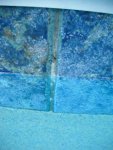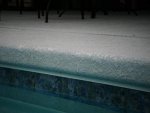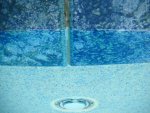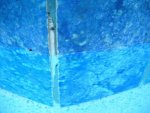Does this look like calcium. The pool is now about 1 1/2 years old. I have a TF 100 test kit for a long time now, have have kept chem numbers inline for a TFP. If this is calcium, I am clueless as what is causing it, since I do my nown test, and keep the water inline with the numbers that they should be. The other things that has me confused if it is, why there is not more of it around the pool.
The picture is of grout inbetween tile at the water line. There are (I guess) over 150 of these joints around the pool. and there are only 6 to 8 joints like this. If it was because of calcium, seems like there should be more. Nothing I do, (we have well water, with no iron), in balancing the water, changes this or seems to stop it from happening. It also seems to crystallize in the same spots. Never seems to start anything, anywhere else in the pool. I can take pics of a couple of the other spots if you need. Also, here are my last test, from yesterday. Any help will be greatly appreciated.
C 5.5
PH 7.8
CH 300
TA 80
CYA 35

The picture is of grout inbetween tile at the water line. There are (I guess) over 150 of these joints around the pool. and there are only 6 to 8 joints like this. If it was because of calcium, seems like there should be more. Nothing I do, (we have well water, with no iron), in balancing the water, changes this or seems to stop it from happening. It also seems to crystallize in the same spots. Never seems to start anything, anywhere else in the pool. I can take pics of a couple of the other spots if you need. Also, here are my last test, from yesterday. Any help will be greatly appreciated.
C 5.5
PH 7.8
CH 300
TA 80
CYA 35





